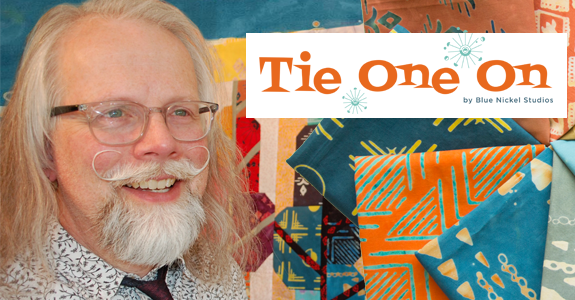
Q&A: SCOTT HANSEN
BLUE NICKEL STUDIOS & BANYAN BATIKS
In 1996, Scott Hansen attended his first Quilt Market in Portland, Oregon.
Now, 22 years later, he’s returning to Portland for spring Quilt Market…
only this time as an exhibitor.
Hansen had the idea to make his first quilt when he was only 14 years old. He didn’t pick quilting back up again until years later, when he gradually began making quilts for family and friends.
He later started designing his own quilt patterns, including one that was published in Quilter’s Home magazine in 2007. His quilts have since appeared in various quilting magazines, and Hansen himself was previously a staff member with Generation Q Magazine, with whom he regularly attended Quilt Market.
Hansen began selling PDF patterns online through his blog, Blue Nickel Studios, and then wholesaling paper patterns through United Notions, Brewer, and Checker in 2016. These days, he’s “Mad Color Scientist” at Blue Nickel Studios, which he runs from his home in the Pacific Northwest.
Over the years, Hansen’s aesthetic has evolved into a personal style he terms “Urban Folk—Modern Design.” He recently applied that same unique style to a new project, designing his first line of fabrics—Tie One On—for Northcott under the Banyan Batiks division.
We spoke with Hansen about the new line and the challenges and surprises he encountered in the process of creating it.
UPCOMING SHOWS
2018
International Quilt Market/Portland
May 18-20
Classes begin May 17
Oregon Convention Center
Portland, Oregon, USA
International Quilt Market/Houston
November 3-5 (NOTE: LATER DATES)
Classes begin November 1
George R. Brown Convention Center
Houston, Texas, USA
International Quilt Market/Kansas City
May 17-19
Classes begin May 16
Kansas City Convention Center
Kansas City, Missouri, USA
International Quilt Market/Houston
October 26-28
Classes begin October 25
George R. Brown Convention Center
Houston, Texas, USA
NOTE: Quilt Market is a credentialed
trade show only, and not open to
the public.
For information on these or any other Quilts, Inc. shows, visit www.quilts.com
2019
Subscribe to our eInsider Newsletter
eINSIDER: First, please tell us a bit about Banyan Batiks. And how did you get involved as a designer for the new division?
HANSEN: Last summer, I got an email from Karen Gibbs. I hadn’t talked to her in a few years, so I was surprised to see her name in my email. She’d just started running Banyan Batiks, a new division of Northcott Fabrics, and told me that she was looking for designers to work with her in her vision of producing patterns and batik fabrics that were not like the typical batiks that have been on the market for decades. I was rather shocked, as I’d told Karen many times that I really don’t like batiks, and I reminded her of that. She said she knew that, but loved my sense of color and design, so she thought that I could help her produce batiks that were not typical.
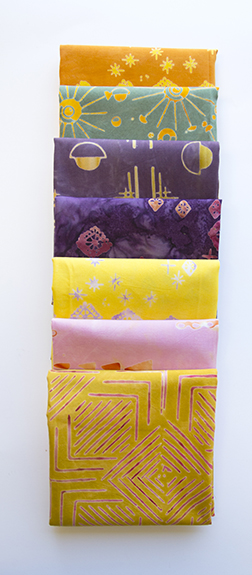 eINSIDER: So, batiks aren’t really your cup of tea. What convinced you to try your hand at designing your own line of batiks then, and has anything about that process come as a pleasant surprise to you?
eINSIDER: So, batiks aren’t really your cup of tea. What convinced you to try your hand at designing your own line of batiks then, and has anything about that process come as a pleasant surprise to you?
HANSEN: As I said, Karen wanted batiks that were not typical. I was intrigued with making batiks that I would like myself, and she told me that she’d help me all throughout the process. Her confidence in me was incredible. I’d been drawing designs that I thought would be fun for fabric for over a decade, but never felt confident enough to work out the repeats. The whole concept of pitching a fabric line to a company was overwhelming to me. But here was a company asking me to do what I had been dabbling in and dreaming of for years—differently than I expected but they were still asking me.
(Fabric Right: Tie One On in the Sedona Colorway)
Part of the process in creating batiks is that handmade element. These are worked out by the Bali artisans, not just some calculated dye process in a manufacturing plant. So, there is an element of surprise when the strike-offs come back, because some of the combinations I loved didn’t do well in the batik process, due to the reaction of the various dyes chosen. With batiks, there need to be particular spaces and widths of lines so the design won’t blur together. We had to change the scale of some of my designs to get them to print well. I can tell this will be a grand adventure in color as I grow in my understanding of batik production.
Besides getting my own strike-offs for the first time, another pleasant surprise was seeing another quilt designer’s quilt plan with digital images of my fabric. I am so very excited to see what people create with Tie One On! I realized that people might really like clothes out of these. I hadn’t even considered that when I initially designed these, and now I see that is a very likely possibility. Bags, aprons, storage items…I am so excited to see them all!
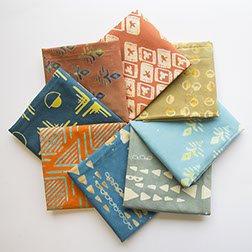 eINSIDER: What do you feel makes your line of batiks different than others out there—and in particular, the batik designs we all know?
eINSIDER: What do you feel makes your line of batiks different than others out there—and in particular, the batik designs we all know?
HANSEN: For starters, I will probably never do leaves or animals as motifs. I think those are very overdone in the batik world. It’s funny, I’ve never really liked modern Scandinavian design, and the whole reason I got into quilting was the old-fashioned country feel of vintage quilts. But now, I am finding myself drawn to more modern lines and shapes. Even though I like the lines of modern design, I also love the organic interpretation of those modern lines inherent in the batik process. As I continue to design, I will likely treat my batiks in a similar manner, with lots of geometry mixed with natural influences. I call my quilt design aesthetic “Urban Folk,” so I believe my batik designs will follow that vibe.
(Fabric Right: Tie One On in the Nashville Colorway)
I’m also drawn to much crisper color combinations. The main thing about batiks that I’ve personally never liked is the mottled forest floor feel most batiks have. I love the forests and the ground underneath, but I don’t like that look in my fabric. I will be sticking to a modern palette that will be bright and colorful, but not all mushed together.
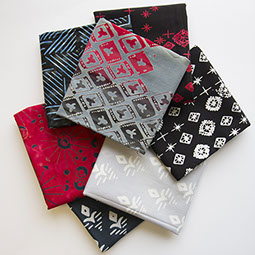 eINSIDER: You describe this new project as an “intriguing challenge.” What has been the most challenging part?
eINSIDER: You describe this new project as an “intriguing challenge.” What has been the most challenging part?
HANSEN: Probably two things. For starters, the waiting period to see the fabric. My collection hit the factories in the middle of a very bad rainy season in Bali, as well as a volcano eruption. That slowed the very organic process of creating the fabric even more than normal. I have heard of designers having to wait for their product, but what I didn’t realize was how agonizing it can be!
(Fabric Right: Tie One On in the Manhattan Colorway)
Secondly, there’s something that I touched on a bit already. When designing batiks, you are more of a guide than absolute ruler over your designs. There is a bit of leeway on the ultimate outcome. Sometimes the factory has a hard time with you color choices—some of this is a bit cultural, while some of it is that the dyes simply don’t play nicely together, so you have to come up with something different. Some of the designs and color choices just don’t mesh, and your end result is less rigid.
For example, one of my favorite designs in the collection only made it into one of the final prints, while another one worked in five colors. So, in the four colorways, one repeats itself in another color. I find this intriguing and quite fun, and totally different than the formulas followed in almost every regular cotton print.
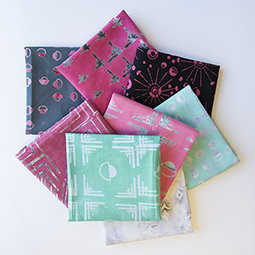 eINSIDER: Your first Quilt Market was 22 years ago, and now you’re attending Market with your own booth! How does that make you feel?
eINSIDER: Your first Quilt Market was 22 years ago, and now you’re attending Market with your own booth! How does that make you feel?
HANSEN: I am beyond thrilled to finally have my own booth at Market. The whole Blue Nickel Studios gig has been my side gig, as I am the sole supporter for my family, and I have never wanted to let go of the safety net of the Regular Day Job. I did that once in the middle of the recession, and it was very scary. I have established many strong friendships in this industry, but I have always been a bit on the edge of the action. I am very excited to finally be there for the whole party!
(Fabric Right: Tie One On in the Ventura Colorway)
eINSIDER: Finally, tell us what keeps you motivated and passionate about quilting?
HANSEN: My passion for color and design never seems to extinguish. I’m very observant and keep notebooks with ideas for quilts and fabric all over the place. I have for years. My kids will be amazed at how many things I have drawn up when my time is up on this planet. I already have at least 20 quilt designs that I want to make, but I just haven’t had the time…and then I think up some more. Seeing my designs go from paper to quilts and now in fabric will never ever cease to bless my heart. I am so grateful to God for this passion and sense of wonder over color, design, and form.
©Quintessential Quilt Media, 2018. All rights reserved.
7660 Woodway
Suite 550
Houston, Texas 77063
U.S.A.
Telephone (1) 713.781.6864
Fax (1) 713.781.8182
e-mail: shows@quilts.com

News and Trends from International Quilt Market
